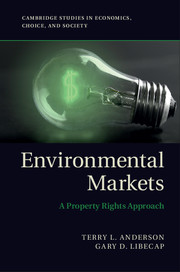Book contents
- Frontmatter
- Contents
- List of Figures and Tables
- Preface
- Acknowledgments
- 1 Who Owns the Environment?
- 2 Is Government Regulation the Solution?
- 3 Property Rights for the Common Pool
- 4 Local Property Rights to the Commons
- 5 The Politics of Property Rights
- 6 From Property Rights to Markets
- 7 Tackling the Global Commons
- 8 Property Rights and Environmental Markets
- Index
- References
3 - Property Rights for the Common Pool
Published online by Cambridge University Press: 05 July 2014
- Frontmatter
- Contents
- List of Figures and Tables
- Preface
- Acknowledgments
- 1 Who Owns the Environment?
- 2 Is Government Regulation the Solution?
- 3 Property Rights for the Common Pool
- 4 Local Property Rights to the Commons
- 5 The Politics of Property Rights
- 6 From Property Rights to Markets
- 7 Tackling the Global Commons
- 8 Property Rights and Environmental Markets
- Index
- References
Summary
Having considered the prospects and pitfalls of government provision of environmental goods and services in Chapter 2, we now turn to the same for markets. In this chapter we carefully examine the arguments of Ronald Coase as they relate to property rights and bargaining costs in the context of environmental markets. Coase is noted for building his analysis on the assumption of zero transaction costs and for concluding that under that condition, resources will be efficiently allocated. We recognize the usefulness of this approach for understanding the relationship between property rights and social costs. Our emphasis in this chapter, however, is on the potential for markets to lower transaction costs relative to those encountered in governmental regulation and to thereby provide environmental goods and services more efficiently.
To be sure, transaction costs might impede market solutions when there are ill-defined and ill-enforced property rights that cannot be easily changed, large numbers of bargaining parties, free riders, limited or asymmetric information about the environmental problem, or non-competitive markets. We do not discount the importance of market transaction costs, but rather compare them with the transaction costs inherent in government regulation. One advantage of markets, even in the presence of such costs, is that they can be more flexible than government regulations in the face of changing resource values and technology. It is in the interest of market participants to respond effectively and quickly, particularly as the markets are more competitive. Government officials are not direct residual claimants in these situations and have more constituents and political interests to consider in determining how to react to new conditions. This explains why, for example, many government policies and agencies remain long after the conditions that led to their creation have disappeared.
- Type
- Chapter
- Information
- Environmental MarketsA Property Rights Approach, pp. 53 - 91Publisher: Cambridge University PressPrint publication year: 2014



